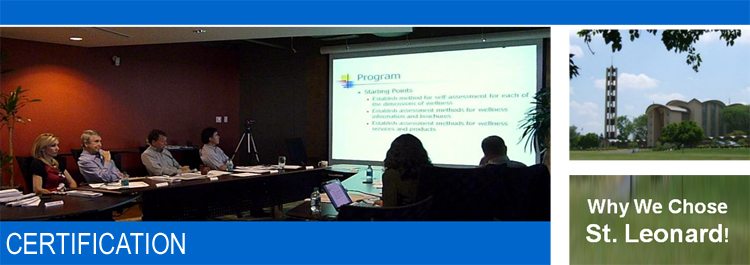

WHY ST. LEONARD?
After our exciting peer review and visioning session in Atlanta in 2008 the next step was to leap from the safety of philosophy, academics, science efficacy and knowledge and to implement the program into a real world context.
We chose the Continuing Care Retirement Community (CCRC) as our test vehicle because it had the triad of life-phase services, of Independent Living, Assisted Living, and Skilled Care Nursing all in one homogenous community within small manageable campuses, normally with 250-1000 persons.
The average age in these communities for the residents was somewhere between 80-85, therefore they had the most to gain by reducing their risk of chronic illnesses and disease.
We Chose St. Leonard
We chose St. Leonard because it was a CCRC, and because its' CEO, Tim Dressman, was determined after his first exposure to the VLCWP to have his community become the first certified Vital Life Community in America.
His community St. Leonard already had the pedigree as one of the premier CCRC's in the U.S., located in Centerville, Ohio, near Dayton, on 200 acres. Their reputation was exceptional and therefore if they succeeded, their endorsement would carry tremendous efficacy as to the practicality and benefits of the VLCWP.
These particulars combined with their Wellness Director, Debra Stewart, her education, and continuous search for excellence which resulted in many industry accolades, rounded out what we thought would be the championship team to showcase the merits of a Vital Life Community Wellness Program.
Annual CERTIFICATION
Just prior to the end of each successive 12 month involvement in the Vital Life Community Wellness Program (VLCWP), the team at the Vital Nation, and the team implementing the program at the host community - St. Leonard - began going over the protocol steps and data to insure that the construct of the VLCWP was being met and that the metrics indicated positive trends towards fulfillment of the required program performance criteria.
These steps are clearly spelled out in the "Requirements" section of this website. These steps, however, are but a framework, and it is up to each member community to put it's own signature on its methodology and content such that it meets the norms of its regional culture, internal demography and operational capabilities. There is flexibility in these constructs; what is not flexible however, is the performance by measure requiring a steady increase in population participation and inclusiveness of the community by whatever means.
In so doing, the brand "Vital Life" has viability as a communicable standard of performance outcome to the resident and market population, who want to be assured of performance before they make the move to join and become one within the fabric of community, as opposed to relying only on the promises of the marketing literature or website.
The true marketing literature is the community's required blog, and the true value of the community's efforts and purpose-driven program are the statistics and the transparency by with which that data is communicated to both outside and internal interests.
REVIEW
It is the Blog, Resident Survey results, and the data of Resident Participation as well as the nature of the focus of the program (8-human ecologies) that the VLCWP Board of Directors reviews each year in order to ascertain that the goals have been met and that the community by performance has "earned" the right to use by license the Vital Life logo trademark in their marketing for the next 12 months.
The review process of the efficacy of the outcome of the previous 12 months is a not an "all or nothing" proposition. On a quarterly basis, interaction between the community and the VLCWP personnel is on-going, with much information flow, strategic discussions, lessons learned, and tactical discussions as to how to mitigate various hurdles, as well as to celebrate individual program component successes. Tim Dressman, Debra Stewart and Bill Witte (Executive Director The Vital Nation) had many conversations, and exchanged scores of e-mails during the annual period; Debra was developing templates, tools, and other learning modules to help enhance the VLCWP insertion and effectiveness.
The annual review, which the photograph at the top of this page records, is one of mutual information exchange, questions, and dialogue, punctuated with the prescribed data and measure required.
Given that St. Leonard was chosen to be the lead Beta tester and implementation team member, the reporting was a tremendous learning session for the VLCWP board members, seeking to continuously hone and improve the program. Remember the program is free to a chosen community, so it is in the interests of both parties to succeed, as both are dedicated to life quality improvements and evolutionary changes in the late aging process of our nation's population. Only by exemplary example can we create the vital idea that will be meaningful and beneficial in helping to solve our nation's healthcare crisis!
SESSION REVIEW CONTENT
In this particular session of two days (May 2012), St. Leonard:
- Gave a report with a PowerPoint presentation
- Passed out copious handouts of numerous types of materials and data
- Were interviewed on camera, so their reflections, experiences and advice could anecdotally be shared with America, and especially other communities interested in the program, as well as recorded for "posterity"
- Offered VLCWP Advice and techniques in the manner of "lessons learned" that would be valuable for inclusion in the VLCWP literature, website and white papers in the future
- Outlined a 10-Year Strategic Program for St. Leonard, that they intended to implement and achieve